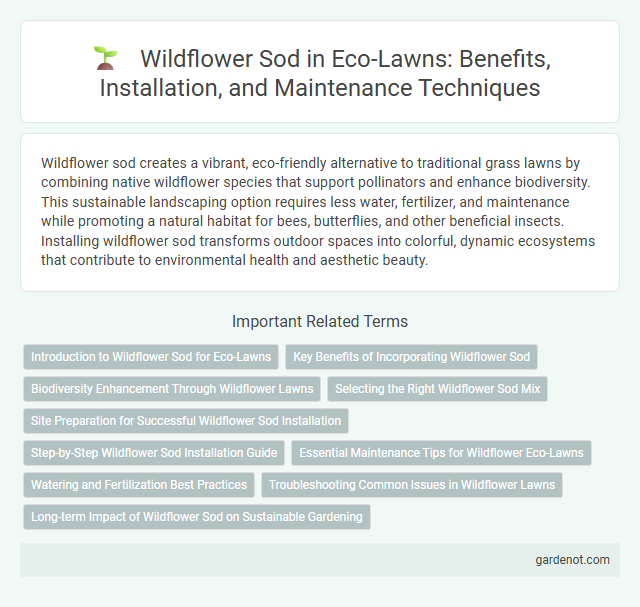Wildflower sod creates a vibrant, eco-friendly alternative to traditional grass lawns by combining native wildflower species that support pollinators and enhance biodiversity. This sustainable landscaping option requires less water, fertilizer, and maintenance while promoting a natural habitat for bees, butterflies, and other beneficial insects. Installing wildflower sod transforms outdoor spaces into colorful, dynamic ecosystems that contribute to environmental health and aesthetic beauty.
Introduction to Wildflower Sod for Eco-Lawns
Wildflower sod offers a sustainable alternative for eco-lawns by combining native wildflower species into pre-grown, easy-to-install mats that promote biodiversity and support local pollinators. This natural ground cover reduces the need for watering, fertilizers, and mowing compared to traditional grass, making it ideal for environmentally conscious landscaping. Using wildflower sod enhances soil health and creates vibrant habitats that attract beneficial insects and birds throughout the growing season.
Key Benefits of Incorporating Wildflower Sod
Wildflower sod enhances biodiversity by supporting pollinators such as bees and butterflies, crucial for ecosystem health. Its low-maintenance nature reduces water usage and the need for chemical fertilizers, promoting sustainable landscaping practices. This eco-friendly ground cover also improves soil quality and provides aesthetic value with vibrant seasonal blooms.
Biodiversity Enhancement Through Wildflower Lawns
Wildflower sod significantly enhances biodiversity by providing diverse habitats for pollinators such as bees, butterflies, and native insects, promoting ecological balance. These wildflower lawns support a variety of plant species that improve soil health and increase resilience against pests and diseases compared to traditional grass sod. Integrating wildflower sod in eco-lawn projects contributes to local wildlife conservation efforts and enriches urban green spaces with vibrant, sustainable ecosystems.
Selecting the Right Wildflower Sod Mix
Selecting the right wildflower sod mix involves considering local climate, soil type, and desired bloom period to ensure optimal growth and sustainability. A mixture containing native species promotes biodiversity, supports pollinators, and requires less maintenance compared to non-native options. Prioritize blends with a balance of annuals and perennials to achieve vibrant, continuous blooms and enhance the eco-lawn's resilience.
Site Preparation for Successful Wildflower Sod Installation
Proper site preparation for wildflower sod installation involves thorough soil testing to determine pH and nutrient levels, ensuring optimal conditions for seed germination and root growth. Removing existing vegetation and debris, followed by loosening and leveling the soil, promotes strong sod establishment and reduces competition from weeds. Incorporating organic matter and applying a starter fertilizer tailored for wildflowers enhances soil fertility and moisture retention, crucial for successful wildflower sod establishment.
Step-by-Step Wildflower Sod Installation Guide
Wildflower sod installation begins with site preparation, including soil testing, clearing debris, and leveling the ground to ensure optimal root development. Next, lay the sod carefully, aligning edges and pressing firmly for good soil contact, followed by thorough watering to promote establishment. Regular maintenance involves consistent watering, mowing at a higher setting, and monitoring for pests to sustain a vibrant eco-friendly lawn.
Essential Maintenance Tips for Wildflower Eco-Lawns
Wildflower sod in eco-lawns requires consistent watering for the first three weeks to establish deep root systems essential for drought resistance and soil stability. Regular mowing at a height of 3 to 4 inches encourages healthy growth while preserving wildflower biodiversity and preventing weed dominance. Applying organic mulch and avoiding synthetic fertilizers supports soil health and promotes vibrant, sustainable wildflower sod.
Watering and Fertilization Best Practices
Wildflower sod requires careful watering to establish deep roots, typically receiving 1 to 1.5 inches of water per week, applied early in the morning to minimize evaporation and fungal growth. Fertilization should be minimal, using a slow-release, low-nitrogen fertilizer in early spring to promote healthy growth without encouraging excessive leafy growth that can overshadow flowers. Proper watering and fertilization enhance drought tolerance and encourage vibrant, long-lasting blooms in eco-lawn environments.
Troubleshooting Common Issues in Wildflower Lawns
Wildflower sod may encounter challenges such as uneven growth, weed intrusion, and inadequate soil moisture, which can hinder its vibrant appearance. Addressing these issues involves proper soil preparation, ensuring consistent watering schedules, and selectively removing invasive plants to maintain biodiversity. Regular monitoring and tailored fertilization can enhance wildflower lawn resilience and promote healthy, sustainable growth throughout the seasons.
Long-term Impact of Wildflower Sod on Sustainable Gardening
Wildflower sod enhances sustainable gardening by promoting biodiversity and improving soil health through deep root systems that reduce erosion and increase water retention. Its long-term impact includes supporting pollinators and beneficial insects, fostering a resilient ecosystem that requires less chemical input and irrigation. Over time, wildflower sod contributes to carbon sequestration, helping mitigate climate change while maintaining vibrant, eco-friendly landscapes.
Wildflower sod Infographic

 gardenot.com
gardenot.com